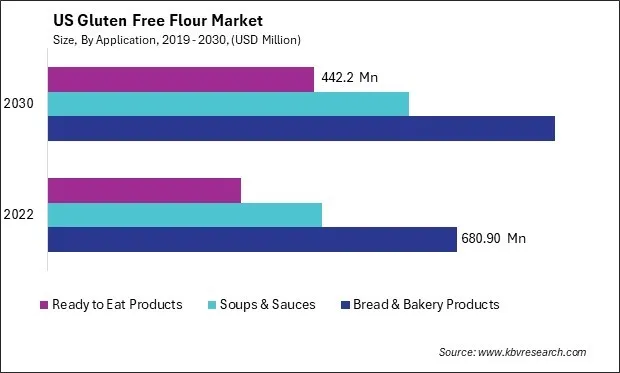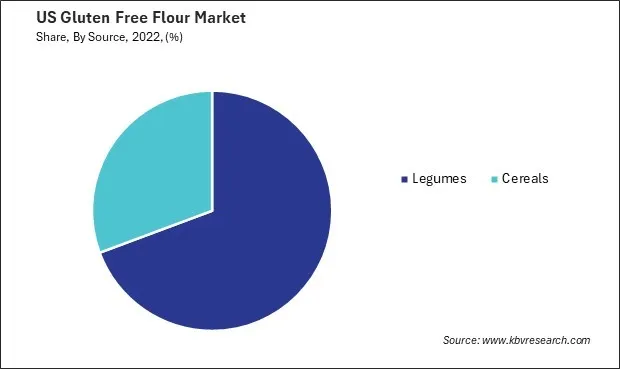The United States (US) Gluten Free Flour Market size is expected to reach $1.9 Billion by 2030, rising at a market growth of 3.3% CAGR during the forecast period. In the year 2022, the market attained a volume of 175.4 Kilo Tonnes, experiencing a growth of 3.6% (2019-2022).
The US gluten free flour market has seen a remarkable surge in demand in recent years, driven by factors that reflect evolving consumer preferences and industry dynamics. One of the key recent developments in the US gluten free flour market is the heightened emphasis on health and wellness among consumers. This trend has led to a significant increase in demand for gluten-free products, including flour, as consumers seek healthier alternatives to traditional wheat-based products. Manufacturers have increased their investments in research and development to produce novel gluten-free flour blends that satisfy nutritional and sensory demands in response to this change in consumer behavior.

Furthermore, non-celiac gluten sensitivity (NCGS), a condition characterized by symptoms resembling those of celiac disease but without a positive diagnostic test result, has garnered increased attention. As more information about NCGS has become available, many individuals who experience gluten-related symptoms but do not have celiac disease have turned to gluten-free diets as a way to manage their health.
Another notable development is the expansion of distribution channels for gluten-free flour products. Previously confined to specialty health stores, gluten-free flour products are increasingly available in mainstream supermarkets and online retail platforms. This broader accessibility has contributed to the market's growth by reaching a wider consumer base and making gluten-free options more convenient for consumers across diverse demographics.

Bread and bakery products hold a prominent place in the American diet, serving as staple food items for many households and a key component of meals and snacks. One of the primary drivers of the demand for bread and bakery products is their widespread availability and convenience. Nationwide availability in bakeries, supermarkets, and convenience stores renders these items a practical alternative for individuals seeking expedient and uncomplicated meal alternatives. The variety of bread and bakery products available, including sliced bread, rolls, bagels, pastries, and artisanal bread, caters to a wide range of tastes and preferences, further contributing to their popularity.
Their cultural and culinary significance is another significant factor contributing to the demand for bread and bakery products. Many bread and bakery products have a long-standing tradition in various regional cuisines and cultural practices across the US, contributing to their popularity and consumption. For example, certain types of bread, such as sourdough or cornbread, are deeply rooted in specific culinary traditions and are valued for their unique flavors and textures.
Furthermore, the demand for gluten-free flour has also been influenced by the broader trend towards healthier and more inclusive food choices. Many consumers seek products that align with their dietary preferences, including gluten-free options catering to specific dietary needs or restrictions. This trend has increased the availability and variety of gluten-free flour products in mainstream supermarkets and specialty stores, reflecting the growing demand for these alternatives among a broader consumer base.
In recent years, there has been a noticeable increase in celiac disease awareness in the United States. One significant factor in the rise of celiac disease awareness is improved diagnostic methods and testing protocols. According to the National Institute of Diabetes and Digestive and Kidney Diseases estimations, about 2 million people in the United States have celiac disease. Scientific and technological progress has produced more precise and dependable diagnostic assays for celiac disease, thereby simplifying identifying the condition. This has resulted in more people receiving a proper diagnosis and understanding the importance of a gluten-free diet in managing the disease.
Another factor contributing to increased awareness is the efforts of advocacy groups and organizations dedicated to celiac disease education and support. These groups work to raise awareness about the signs, symptoms, and management of celiac disease through public awareness campaigns, educational materials, and community outreach programs. Their efforts have helped to dispel myths and misconceptions about the condition and have empowered individuals to seek proper diagnosis and treatment.
The increasing incidence of celiac disease carries substantial ramifications for both the food industry and public health. As a result, food manufacturers have been compelled to develop a more extensive range of gluten-free alternatives to accommodate people who have celiac disease and gluten sensitivities in response to the increased demand for such products. Efforts to diagnose as well as manage celiac disease are expected to increase in tandem with heightened awareness of the condition, thereby exerting additional influence on the gluten-free product and dietary choices landscape in the United States.

The US gluten free flour market is home to a variety of companies that cater to the increasing demand for gluten-free products driven by factors such as celiac disease awareness, gluten sensitivity, and consumer preference for gluten-free diets. Some prominent companies in this market offer a wide range of gluten-free flour options to meet the diverse needs of consumers.
One of the leading players in the US gluten free flour market is Bob's Red Mill. Known for its extensive line of gluten-free products, Bob's Red Mill offers a range of gluten-free flours, including almond flour, coconut flour, and various gluten-free baking flour blends. The company is recognized for its commitment to quality and has established a strong presence in the gluten free flour market.
King Arthur Baking Company is another key US gluten free flour market player. The company offers a popular Gluten-Free Measure for Measure Flour, a 1:1 substitute for all-purpose wheat flour in recipes. Belonging to a devoted clientele of individuals in search of gluten-free alternatives, King Arthur Baking Company is renowned for its superior baking products.
Cup4Cup is a brand that has gained prominence in the gluten free flour market for its innovative approach to gluten-free baking. The company's gluten-free flour blend is designed to mimic the taste and texture of traditional wheat flour, making it a popular choice for consumers looking for a seamless transition to gluten-free baking.
Arrowhead Mills is another established player in the US gluten free flour market, offering a variety of organic and gluten-free flour, including brown rice flour, coconut flour, and other specialty flour blends. The company's focus on organic and natural ingredients has resonated with health-conscious consumers seeking gluten-free options.
Namaste Foods is known for its allergen-friendly products, including gluten-free flour blends from brown rice flour, sorghum flour, and tapioca flour. The company's emphasis on allergen safety and quality has helped it carve out a niche in the gluten free flour market.
These companies are just a few examples of the many US gluten free flour market players. As consumer demand for gluten-free products continues to grow, these companies, along with others in the industry, are likely to play a crucial role in meeting the needs of consumers seeking gluten-free alternatives for their baking and cooking needs.
By Application
By Source
By Product
Our team of dedicated experts can provide you with attractive expansion opportunities for your business.

